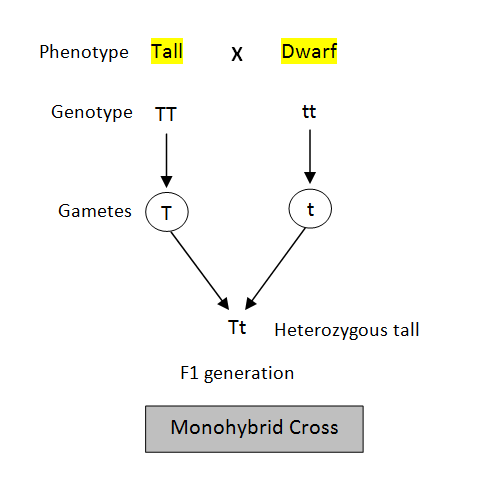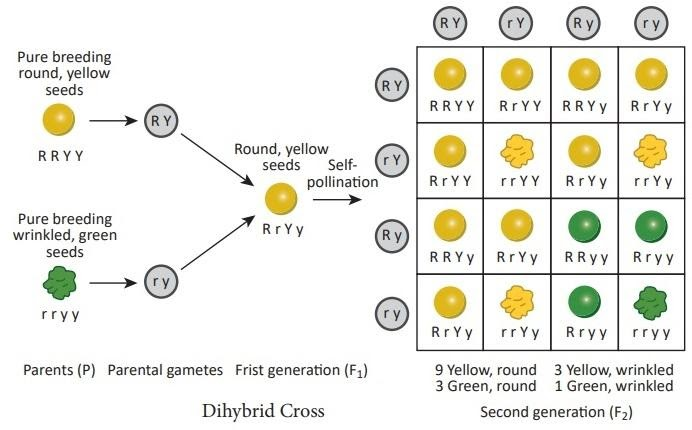Monohybrid and Dihybrid Crosses: Definitions, Ratios, and Examples
When Gregor Johann Mendel first conducted his classical experiments on pea plants, he laid the foundation for how we understand genetics today. Two fundamental types of genetic crosses he performed are the monohybrid cross and the dihybrid cross. In simple terms, a monohybrid cross focuses on one trait at a time, whereas a dihybrid cross considers two traits simultaneously. Below, we will explore what is monohybrid and dihybrid cross with an example, highlight their distinguishing features, and address the difference between monohybrid and dihybrid cross in detail.
What are Monohybrid and Dihybrid Crosses?
Before delving into the monohybrid and dihybrid cross-difference, let us establish their definitions clearly:
Monohybrid Cross: A monohybrid cross is a breeding experiment between organisms that differ in only one trait. For example, crossing a pea plant with dominant tall height (TT) and another pea plant with recessive dwarf height (tt) is a monohybrid cross. Here, you are studying how one pair of contrasting alleles (T vs t) is passed down through generations.
Dihybrid Cross: A dihybrid cross studies the inheritance pattern of two different traits simultaneously. For instance, crossing pea plants that differ in both seed shape (round vs wrinkled) and seed colour (yellow vs green) constitute a dihybrid cross. This allows us to observe how two pairs of contrasting alleles are inherited together.

Understanding these concepts is crucial because they directly relate to Mendel's laws of inheritance, including the Law of Segregation and the Law of Independent Assortment.

Key Features and Ratios
A core part of understanding the difference between monohybrid and dihybrid cross is looking at the genotypic and phenotypic ratios obtained from these genetic experiments.
Monohybrid Cross Ratios
Phenotypic Ratio: 3:1
In the classic example of tall (dominant) vs dwarf (recessive) pea plants, three offspring show the dominant tall trait for every dwarf offspring.Genotypic Ratio: 1:2:1
If you denote the dominant allele as T and the recessive as t, the ratio of TT:Tt:tt is 1:2:1.Test Cross Ratio: 1:1
When you perform a test cross (crossing a plant with a homozygous recessive individual), the ratio of the dominant phenotype to the recessive phenotype is 1:1 if the original plant is heterozygous.
Dihybrid Cross Ratios
Phenotypic Ratio: 9:3:3:1
If you consider seed shape (round - R, wrinkled - r) and seed colour (yellow - Y, green - y) in pea plants, you get four types of offspring in the ratio of 9:3:3:1. Nine show both dominant traits (round, yellow), three shows one dominant and one recessive trait (round, green), another three show the other dominant and recessive trait (wrinkled, yellow), and one shows both recessive traits (wrinkled, green).Genotypic Ratio: 1:2:1:2:4:2:1:2:1
Though less commonly memorised than the phenotypic ratio, this comprehensive genotypic breakdown represents each possible combination of R/r and Y/y alleles.Test Cross Ratio: 1:1:1:1
A dihybrid test cross with a double recessive individual (rryy) will produce offspring in equal proportions of the four possible phenotypes.
Difference Between Monohybrid and Dihybrid Cross
Here is a concise look at the monohybrid and dihybrid cross-difference in tabular form:
What is Monohybrid and Dihybrid Cross With an Example?
To solidify your understanding of monohybrid and dihybrid cross, let us explore classical pea plant examples:
Monohybrid Cross Example
Parental Generation (P): Tall plant (TT) × Dwarf plant (tt)
F1 Generation (All Tt): All plants appear tall (T is dominant)
F2 Generation: When F1 plants are self-fertilised, they produce a ratio of 3 tall:1 dwarf.
Dihybrid Cross Example
Parental Generation (P): Round-yellow (RRYY) × Wrinkled-green (rryy)
F1 Generation (All RrYy): All seeds are round-yellow (dominant traits)
F2 Generation: On selfing the F1, seeds appear in the ratio of 9 round-yellow : 3 round-green : 3 wrinkled-yellow: 1 wrinkled-green.
These examples illustrate what is monohybrid and dihybrid cross with an example in the simplest possible way, demonstrating how different traits are inherited.
Quick Quiz
Test your understanding of monohybrid and dihybrid cross:
1. In a monohybrid cross involving pea plants (T = tall, t = dwarf), the F1 offspring are:
A. All tall
B. All dwarf
C. Half tall, half-dwarf
D. 3 tall:1 dwarf
2. Which of the following best represents the phenotypic ratio in a dihybrid cross?
A. 9:3:3:1
B. 3:1
C. 1:2:1
D. 1:1
(Answers: 1–A, 2–A)
Why are These Crosses Important?
Learning the difference between monohybrid and dihybrid cross is crucial for anyone studying genetics because it forms the basis for understanding more complex inheritance patterns. These crosses are often extended to study polygenic inheritance, linked genes, and even genetic disorders in humans.
If you would like a deeper dive into these foundational concepts, explore our dedicated resource on Mendel’s laws of inheritance and how they apply to modern genetics.


FAQs on Monohybrid vs Dihybrid Cross: Complete Guide for Students
1: How do I differentiate between a monohybrid cross and a dihybrid cross quickly?
Monohybrid crosses involve a single pair of contrasting traits, typically resulting in a 3:1 phenotypic ratio in the F2 generation. Dihybrid crosses to deal with two pairs of contrasting traits at the same time and typically show a 9:3:3:1 phenotypic ratio.
2: Why is the dihybrid test cross ratio 1:1:1:1?
In a dihybrid test cross, the individual with the dominant phenotype for two traits is crossed with a double recessive (rryy). Each type of gamete from the dominant parent can pair equally with the recessive gametes, leading to four equal phenotype categories.
3: Can monohybrid and dihybrid crosses be performed in organisms other than pea plants?
Yes, any organism (plants or animals) that reproduces sexually and has easily observable traits can be used for such crosses. Pea plants were Mendel’s choice due to their distinct traits and short generation time.
4: Are the genotypic ratios the same for all traits in a dihybrid cross?
The genotypic ratio for a dihybrid cross (1:2:1:2:4:2:1:2:1) remains consistent if the traits are independently assorted (not linked). If the genes are linked, these ratios can deviate significantly.










